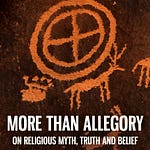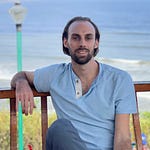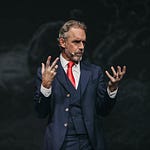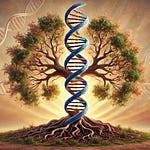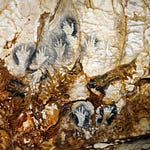Åsmund Folkestad, physicist, ML scientist, and Substacker (Mechanics of Aesthetics) joins me to discuss beauty, language, and God. There are no easy answer, it seems, as God is NaN.
🎙️ Show Notes
1. Introduction
Andrew introduces Åsmund Folkestad — physicist, Substack writer, and creator of “rave cathedrals,” an art form blending psytrance with Western mysticism rather than Eastern motifs.
Åsmund’s background: PhD in physics, currently working on natural language processing for scientific discovery, exploring beauty, mysticism, and language in his Substack essays.
Discussion begins with the shared fascination for cathedrals as living embodiments of geometry, devotion, and the longing for collective purpose.
2. The Aesthetics of Cathedrals
Åsmund describes Gothic cathedrals as “perfect geometry — the balance between minimalism and grandeur.”
The sense of awe and longing they inspire — a nostalgia for civilizations united by shared ideals.
Comparison between medieval cathedrals and modern equivalents such as the James Webb Space Telescope, seen as “the cathedral of science.”
Andrew notes how his youthful anti-hierarchical stance once made him see cathedrals as monuments built on blood — but maturity brought a reconciliation between beauty and human imperfection.
They discuss cathedrals as a universal language of transcendence: a didactic architecture understandable across centuries and illiteracy.
3. From Black Metal to the Divine
Åsmund’s upbringing in Norway: Protestant family of organists; summers spent in monastic silence overlooking lakes — early contact with beauty and sacred quiet.
Teenage rebellion through black metal and atheism, rejecting religion as “the uncoolest thing in the world.”
Later realization: both theists and atheists may be “asking the wrong question.”
The statement “God exists” is ill-defined rather than true or false.
He argues that theism, atheism, and agnosticism all rely on a flawed linguistic frame.
The problem of “God” as a category error — the question itself may be malformed.
4. On Language, God, and Meaning
Åsmund’s position: the proposition “God exists” is neither true nor false because it cannot be meaningfully defined in logical terms.
Yet, retiring the word God would be a mistake. Language carries ancestral meaning; to discard it is to erase 40,000 years of human reflection.
Andrew connects this continuity to cave paintings as early cathedrals — attempts to elicit shared transcendence long before organized religion.
The pair argue for preserving God as a semantic attractor for experiences humans have continually sought to name.
God, in this sense, refers to patterns of experience that recur in human consciousness.
5. Mystical Experience and the Birth of
Mechanics of Aesthetics
Åsmund recounts a series of ineffable mystical experiences that prompted him to start writing.
His Substack became a tool for “thinking in public” — to test his ideas on beauty and spirituality against criticism and dialogue.
Beauty, for him, is not ornamental but ontological — deeply tied to the structure of reality.
Religion and art are both aesthetic technologies for approaching the transcendent.
6. Physics, Priests, and the Question of God
Andrew proposes that physicists are today’s priests — society’s interpreters of reality.
Åsmund observes that most physicists are default atheists, though not without awe or mystical sentiment.
The physicist’s “God” is often dismissed as redundant once the laws of physics are accepted.
Yet, some exceptions exist (e.g., Aaron Wall, Cambridge; historical figures like Schrödinger).
The conversation explores whether physicists have simply replaced God with Law, maintaining faith in an orderly cosmos.
7. The Intersection of God, Truth, and Logic
Åsmund critiques the worship of “Truth with a capital T.”
Human language ≠ formal logic; statements like “God exists” fail because they cannot be translated into the logical domain.
He distinguishes truth from reality:
True/false belong to mathematics.
Real describes what has causal power in the universe.
Thus, God may not be “true” but might still be real, as a recurring experiential phenomenon with tangible effects on human behavior and consciousness.
Andrew pushes against the reduction of God to “psychological utility,” arguing it feels hollow.
Åsmund agrees: the sacred cannot be fully explained away by sociology or psychology.
8. Natural vs. Supernatural — A False Dichotomy
Åsmund rejects the binary between naturalism and supernaturalism.
The “laws of physics” are not immutable; they are descriptions of patterns, not ultimate truths.
He suggests a universe so complex it might be incompressible — where the only way to know it is to run it.
This raises the possibility that physics itself is not fundamental but an emergent interface
9. The Return to Logos
Andrew brings in John 1:1: “In the beginning was the Word (Logos).”
He reads it as a radical Greek reinterpretation of Genesis — God as structure, order, or law, not anthropomorphic deity.
Åsmund notes the irony that the ineffable is given the name Word.
Both reflect on the continuity from Greek Logos to Christian theology to modern physics — a lineage of faith in an intelligible universe.
10. Closing Thoughts
The conversation circles back to beauty as the interface between the ineffable and the real.
Cathedrals, telescopes, and equations all express the same longing: to glimpse order in chaos.
Åsmund admits his position doesn’t fit any orthodoxy — not atheist, theist, or agnostic — but perhaps aesthetic realist: one who finds divinity in the structure of beauty itself.
Andrew closes on the continuity between prehistoric art and modern science — both descendants of humanity’s first cathedral: the cave.
🌐 Links & References
In the Beginning Was the Word an early essay of mine on psychometrics







